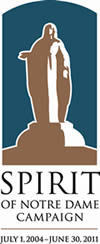
The plan is for Greg Crawford, dean of the College of Science, and his wife, Renate, to climb aboard their bicycles in Tucson in mid-July and pedal 1,500 miles to Notre Dame. The cross-country trek, billed as “Desert to Dome: Riding for the Lives of Children,” can be thought of as symbolically marking a new partnership between the Ara Parseghian Medical Research Foundation and Notre Dame.
You can bet it won’t take too much biking under the Arizona sun in midsummer for the Crawfords to ascertain that the journey is much more than symbolic.
Brian Kelly has a challenge of his own — reviving the fortunes of Fighting Irish football. But months before he leads the team out of the tunnel for its home opener he has already made a major contribution to the institution. It, too, comes with a challenge.
Kelly, Notre Dame’s new head football coach, and his wife, Paqui, have donated $250,000 to the University. Underscoring their personal interests, the benefaction will be directed toward cancer research, the Hesburgh libraries and Notre Dame’s Robinson Community Learning Center (RCLC).
The portion of the donation earmarked for cancer research reflects the family’s personal experience with the disease; Paqui is a breast cancer survivor. The gift will go to the Mike and Josie Harper Cancer Research Institute, opening in Notre Dame’s new Harper Hall and bringing together scientists from Notre Dame and the Indiana University School of Medicine-South Bend. The institute will foster basic and clinical research as it pertains to the diagnosis, treatment and prevention of cancer.
- Ara Parseghian, 1923-2017
- Echoes: When the Irish got their fight back
- Soundings: The time of my life
- Life in the Abyss
- Riding to the challenge
- A cruel disease, a glimmer of hope
- The Boler-Parseghian endowment
The Kellys’ benefaction will provide financial support for the Hesburgh libraries, including the main library and 11 branches across campus.
It will also underwrite programs at the RCLC, an educational and service initiative in South Bend’s northeast neighborhood. Sponsored by Notre Dame in partnership with local residents, the RCLC serves about 500 young people and adults each week as well as another 8,000 children annually through its outreach programs. The gift, evidence of the Kellys’ intent to serve the local community, will support innovative tutoring, violence-prevention, youth entrepreneurship and performing arts for all ages.
The gift also comes with the Coach Kelly Challenge to encourage others to support the University, seeking an initial goal of 2,500 new or renewed donors to Notre Dame before the September 4 football season opener.
These donations will count toward the Spirit of Notre Dame campaign, which concludes in June 2011. While the fundraising effort, the largest such endeavor in the history of Catholic higher education, has exceeded its $1.5 billion goal, important priorities remain underfunded. The challenge is intended to help meet those goals and increase alumni participation in the campaign.
The Crawfords’ epic bike ride also will generate support for institutional initiatives and involve alumni participation through geographic clubs en route. It brings together a profoundly moving Notre Dame story (see Life in the Abyss) with one of the institution’s most important research initiatives.
The story goes back to 1994, the year three of Cindy and Michael Parseghian’s four children were diagnosed with the rare but fatal Niemann-Pick Type C (NPC) disease. Within 11 years, all three of the afflicted children would be gone. NPC, which strikes about 1 in 150,000 children, is one of about 8,000 known rare diseases, a group largely ignored by researchers because it isn’t economically beneficial for the medical and pharmaceutical industries to develop treatments or cures for diseases that affect so few.
Within weeks after their children’s diagnosis the Parseghians, both members of the Class of 1977, started what became the Ara Parseghian Medical Research Foundation, named after Michael’s father, the famed Notre Dame football coach. Under Cindy’s leadership as president, the foundation has supported the scientists who discovered the gene responsible for NPC and identified potential drug therapies for the condition. The foundation, based in Tucson, has become a model for similar efforts combating rare diseases.
At Notre Dame, meanwhile, various faculty members had been researching rare diseases for decades, and in 2001 these investigative efforts were brought together more formally when a new Center for Rare Disease Research was approved by the University.
Beginning in 2003, a group of Notre Dame scientists focusing more intently on NPC research, aided by seed funding from the University’s Office of Research. The Notre Dame programs were coordinated with interdisciplinary research efforts at other universities and medical schools, with the foundation supporting these further investigations.
The Center for Rare and Neglected Diseases also reflects institutional convictions of serving the poor. Such neglected diseases as tuberculosis, malaria and lymphatic filariasis may affect billions in impoverished parts of the world, but pharmaceutical companies have little incentive to develop treatments.
Last fall the Parseghians and the University began to talk about partnering to support research that would combat NPC and eventually other rare diseases affecting children, including cystic fibrosis, thalassemia and several forms of cancer.
The Crawfords, meanwhile, have about a month to make it to campus to open the school year. That’s about 50 miles per day. Just another challenge among many.
Kerry Temple is editor of Notre Dame Magazine.